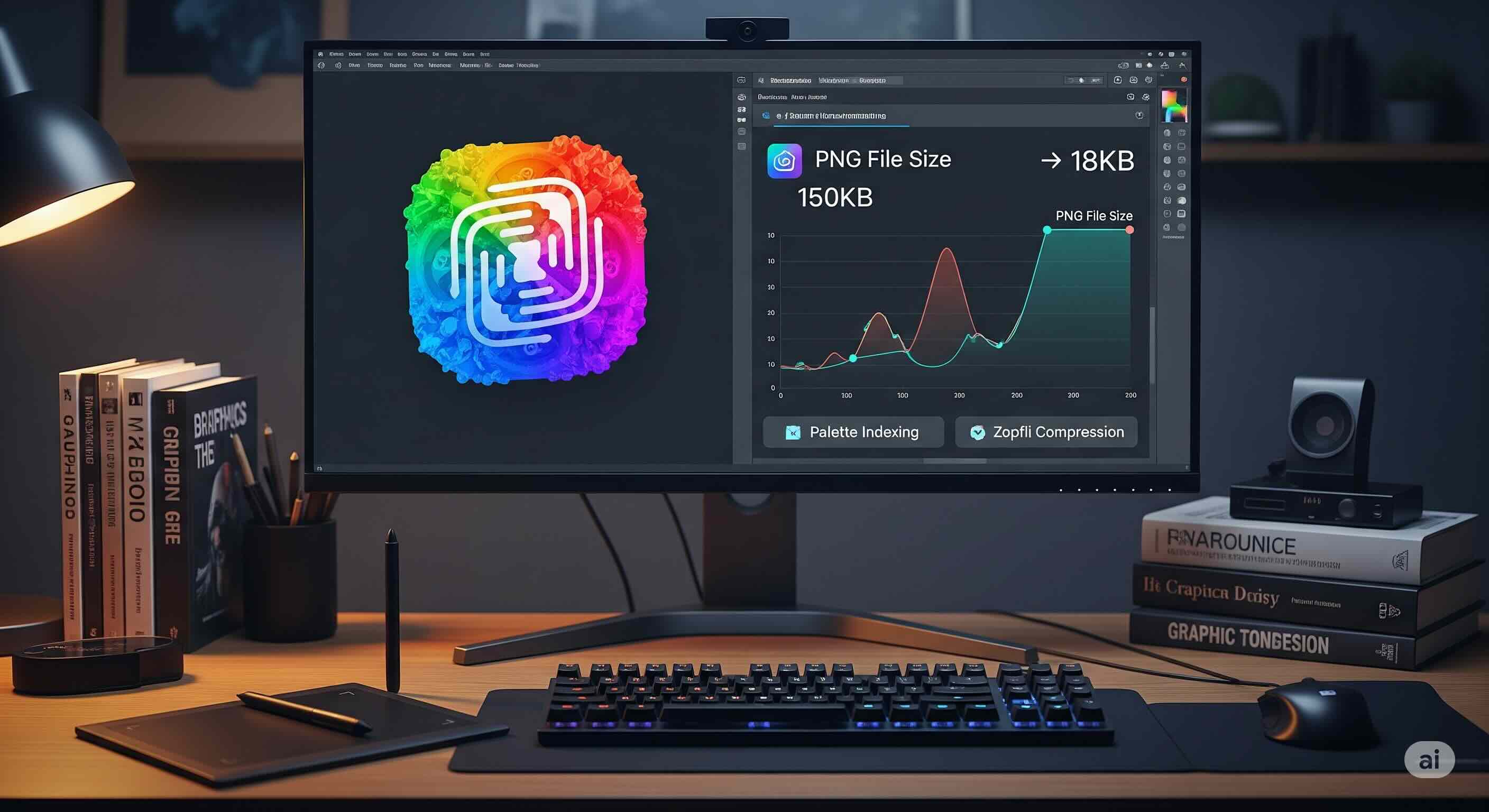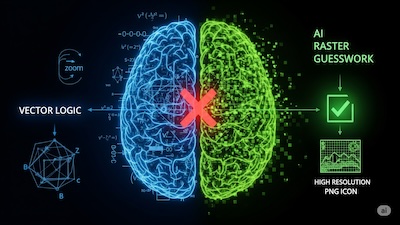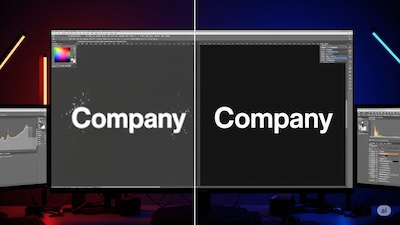The 20KB PNG Challenge: Advanced Compression for SVG-Icon Conversions
 iSVGtoPNG Team
iSVGtoPNG Team

I was once brought in to consult for a high-traffic e-commerce site that was hemorrhaging users on mobile. Their pages were slow, and the bounce rate was astronomical. After running a performance audit, the culprit was immediately obvious: a sea of unoptimized PNG icons, many of which were over 100KB. The "add to cart" icon alone was 85KB. It was a classic case of death by a thousand cuts, or in this case, a thousand kilobytes.
This is a scenario I've seen countless times in my career. A team invests heavily in beautiful SVG iconography, but the final step in their workflow—the SVG to PNG conversion—is treated as an afterthought. The result is bloated, slow-loading raster images that undermine all the hard work that came before. In today's performance-obsessed web, every kilobyte matters. That's why I issue a challenge to the teams I work with: The 20KB PNG Challenge.
The goal is simple: can you get your complex, multi-color icon PNGs under 20KB without a perceptible loss in quality? It's not just possible; it's essential. This guide will take you beyond basic "Save for Web" dialogs and into the world of advanced PNG compression, a critical skill for any serious web developer or designer.
Understanding PNG Bloat: Why Your Icon Files Are So Big
To win the compression game, you must first understand your opponent. PNG is a lossless format, which is fantastic for preserving sharp lines and transparency. However, this fidelity comes at a cost. The bloat in a typical PNG comes from several sources:
| Source of Bloat | What It Means | Why It Increases Size |
|---|---|---|
| Color Depth (PNG-24) | The ability to store 16.7 million colors. | Most icons use few colors, so you're storing millions of unused color possibilities (24 bits per pixel). |
| Metadata | Extra information embedded by design tools (e.g., software version, date). | This data is useless for browsers and adds unnecessary weight. |
| Inefficient Filtering | Sub-optimal rearrangement of pixel data before compression. | Poorly arranged data is harder for the DEFLATE algorithm to compress effectively. |
| Poor Compression Level | The encoder uses a low-effort setting for the DEFLATE algorithm. | A "fast" export doesn't spend enough time finding the most efficient compression patterns. |
Foundation: Why Optimization Starts with a Clean SVG
You can't compress a messy file effectively. The path to a tiny PNG begins with a pristine SVG source. Before you even think about conversion, your SVG must be optimized.
My non-negotiable first step is to run every source SVG through a high-quality SVG optimizer. This process strips out editor-specific junk and simplifies paths, which directly translates to a cleaner, more compressible starting point for your PNG conversion.
Furthermore, if your icon has sharp lines, ensure it's designed on a pixel grid. This minimizes the anti-aliasing needed during rasterization, which is a common source of both blurriness and extra "in-between" colors that are hard to compress. If you're struggling with fuzzy outputs, you need to address the root cause by fixing blurry edges at the source.
The Core Strategy: How Indexed Color (PNG-8) Slashes File Size
This is the single most important technique for dramatically reducing PNG file size. Instead of storing 16.7 million possible colors (PNG-24), you create a limited color palette (up to 256 colors) and "index" every pixel to a color in that palette. This is what's commonly known as PNG-8.
For 99% of icons, you don't need more than 256 colors. By switching to an indexed palette, you change the data storage from 24 bits per pixel to 8 bits or less, instantly slashing the file size by two-thirds or more, even before further compression.
How to Do It Right: Quantization and Dithering
The process of creating this limited palette is called **quantization**. A smart quantization algorithm analyzes your image and creates the optimal palette to represent it. If your icon has gradients, a straight color reduction can cause ugly "banding." **Dithering** is the magic that fixes this by adding a subtle pattern of noise to simulate the missing "in-between" shades. A powerful, modern PNG compressor will give you granular control over these settings.
Advanced Techniques for Maximum PNG Compression
You've converted your clean SVG to an indexed-color PNG. Now it's time for the final squeeze.
1. Aggressive DEFLATE with Better Encoders
Standard PNG encoders are good, but specialized encoders are better. Tools like `ZopfliPNG` (from Google) and `OxiPNG` use more exhaustive search algorithms to find the absolute best DEFLATE compression. They take longer to run but can often squeeze out an extra 5-10% from the file size without any loss of quality.
2. Stripping Unnecessary Chunks
A PNG file is made up of "chunks" of data. You can safely strip ancillary chunks to save space, such as color correction info (gAMA, cHRM), textual metadata (tEXt), and modification times (tIME). A good compression tool will have a "Strip Metadata" option that handles this for you.
The Complete Workflow: Your Step-by-Step Guide to a Sub-20KB PNG
Let's put it all together into a repeatable, professional workflow. If you're dealing with many icons, a batch converter or a build script is your best friend here.
- Optimize the Source: Start by cleaning your source SVG with an SVG optimizer.
- Convert with Indexed Color: Convert the SVG to a PNG, specifically targeting an indexed PNG-8 format. Start with a palette of 32 or 64 colors.
- Apply Dithering (If Needed): If the icon has gradients, apply a subtle ordered dither. If it's all flat colors, turn dithering off.
- Strip Metadata: Ensure all non-essential metadata chunks are stripped from the file.
- Run Advanced Compression: Pass the resulting indexed PNG through an advanced compressor that uses an engine like ZopfliPNG or OxiPNG for the final, aggressive squeeze.
Following this process, I've seen 120KB icons drop to a mere 15KB. It's a game-changer for performance.
Conclusion: The Art and Science of Small PNGs
The 20KB PNG Challenge isn't just about hitting an arbitrary number. It's about cultivating a mindset of performance-first design and development. It forces you to understand the medium you're working with, moving beyond default settings and taking full control of your asset pipeline.
By combining a clean SVG source, the strategic use of indexed color, and the power of advanced compression algorithms, you can create PNGs that are both visually perfect and incredibly lightweight. This mastery over your assets is no longer a "nice-to-have"—it's a fundamental requirement for building fast, professional, and successful web experiences.

iSVGtoPNG Team
iSVGtoPNG Team is a front-end developer and graphics enthusiast with over 10 years of experience in web technologies. She loves exploring the intersection of design and code.


